4.4 Air-sea interaction related to the MJO
There is growing interest in the role that air-sea interaction may play for the dynamics of the Madden-Julian oscillation. Such interest has been motivated by the poor performance of GCMs in simulating and forecasting the MJO. Models with prescribed SST typically produce MJOs that move eastward too fast, are too weak, and have incorrect seasonality. Field programs, such as TOGA COARE, have revealed local swings in SST in excess of 1C in association with passage of the MJO across the warm pool of the Indian and western Pacific Oceans. The forcing and importance of these anomalies both within the MJO cycle itself and as a link with low frequency variations are subjects of CDC research.
4.4.1 The MJO cycle
Comparison of the observed SST tendency and the net surface heat flux into the equatorial western Pacific indicates that surface heat flux forcing by the MJO is likely responsible for the observed intraseasonal SST variations. A detailed study of the surface heat fluxes associated with the MJO indicates the dominance of short wave radiation and latent heat flux. The structure of the MJO is such that minimum surface short wave radiation occurs just prior to maximum latent heat flux. Thus these two fluxes act in concert to cool the ocean after the passage of the convective-windy phase of the MJO. Similarly, increased short wave radiation and reduced latent heat flux act to warm the ocean during the clear-calm phase of the MJO.
The dominance of one dimensional processes for controlling the SST variations associated with the MJO has been demonstrated using a grid of one-dimensional mixed layer models. Each grid was forced with observed surface fluxes for 10 well-defined MJO events. The composite of model output (not shown) indicates that surface heat flux forcing is responsible for the observed intraseasonal SST variations across the equatorial Indian and western Pacific Oceans. This result is at odds with point measurements made during TOGA COARE, which suggests a significant role for horizontal advection. This issue was addressed by repeating the mixed layer model experiments using an Ocean GCM. Again, the observed intraseasonal SST variation produced by the composite MJO was simulated. But, analysis of the role of horizontal advection (Fig. 4.15) emphasizes the dominance of surface heat flux forcing. While horizontal advection is locally large (as in TOGA COARE), it is incoherent on the scale of the MJO.
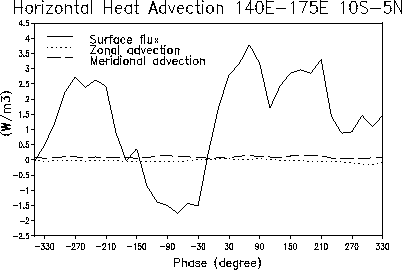
The potential impact of intraseasonal SST anomalies, induced by the MJO, on the dynamics of the MJO was investigated in a GCM coupled to a grid of one dimensional mixed layer models. Simulating the ocean with a mixed layer model is appropriate for this study, as indicated by the above heat budget studies. In the particular GCM used for this study, coupling to an active mixed layer had very little impact on the model's MJO (Fig. 4.16). Unfortunately, due to a poor simulation of the surface structure of the MJO, the model was unable to reproduce the observed coherent eastward propagation of SST. The poor simulation of the surface structure of the MJO stems from both a poor simulation of the mean climate of the warm pool and an improper phasing of short wave radiation and latent heat flux. Thus, it remains an interesting question as to the role of intraseasonal SST anomalies for the dynamics of the MJO, and, for instance, whether prediction of intraseasonal SST is necessary for successful prediction and simulation of the MJO.
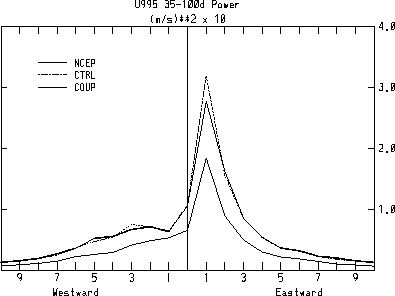
4.4.2 Interannual variation of MJO activity
The level of MJO activity in the Tropics is observed to vary widely from year to year. Understanding this interannual variability is of practical importance because of the role the MJO plays in the Australian and Indian summer monsoons, in forcing oceanic Kelvin waves that dominate the variability of the thermocline in the equatorial eastern Pacific, and the possible role that the MJO may play in the onset and evolution of ENSO. A detailed analysis of the interannual variability of the MJO during winter reveals little relationship between the overall level of activity and SST, including the state of ENSO (Fig. 4.17). Recent analyses of ensembles of GCM experiments have arrived at the same conclusion: most of the year-to-year variability of the level of MJO activity during winter is unrelated to boundary forcing and is thus unpredictable.
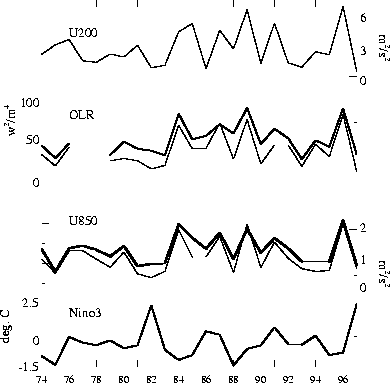
On the other hand, MJO activity is observed to shift eastward during El Niño (Fig. 4.18). This eastward shift may have important dynamical consequences, especially at the onset of warm events. Furthermore, while the contemporaneous correlation between wintertime (DJFM) west Pacific SST and wintertime global MJO activity is small, there is a strong correlation when west Pacific SST leads MJO activity by 1 season. Figure 4.19 shows a scatter plot of MJO activity in winter versus SST anomaly averaged over the west Pacific in the northern fall (SON). The lag correlation depicted is consistent with the synoptic observation that an expanded warm pool promotes strong MJO activity. The weak contemporaneous correlation in winter reflects the cooling effect of enhanced MJO activity on local SSTs. Warm west Pacific SSTs also precede the onset of El Niño, which might lead one to infer a relationship between strong MJO activity and the onset of El Niño. However, of the three winters with the strongest MJO activity, only the winter of 1996-97 (year 96 in the figure) preceded a strong El Niño.
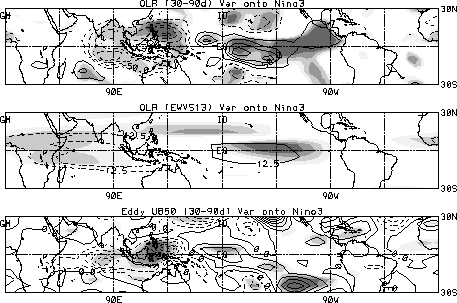
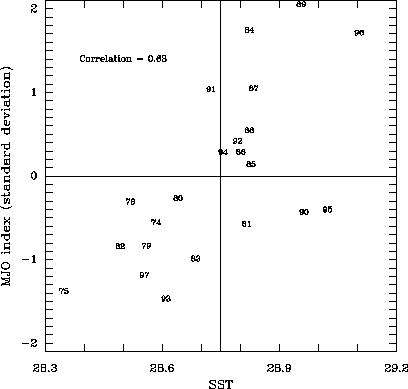
4.4.3 MJO and ENSO
Previous studies have suggested that intraseasonal variations of convection contribute to interannual variations in the tropical Pacific by acting as a triggering mechanism for El Niño. This speculation has increased recently because the 1997-98 El Niño, arguably the strongest of the century, followed exceptionally strong MJO activity during the winter of 1996-97. During the winter of 1996-97 there were two strong MJO events that could have contributed to the evolution of the 1997-98 El Niño. The first occurred during December 1996 and was accompanied by substantial cooling of the west Pacific, initiating a long-term cold anomaly there. The second occurred during February-March 1997 and was accompanied both by cooling in the west Pacific and warming in the central Pacific. The warming in the central Pacific was particularly important. After that warming, central Pacific SSTs remained warm for the next year and convective activity migrated to the central Pacific, signaling the onset of a very strong and rapidly developing El Niño. To help elucidate the potential role of MJO activity for the onset of El Niño, dynamical interactions were examined in the upper ocean that led to the important SST changes in the winter of 1996-97.
SST fluctuations that occurred in the west Pacific (Fig. 4.20a) during convective episodes in December 1996 and February 1997 (shaded periods) were, for the most part, forced by surface flux variations (Fig. 4.20b). Surface cooling was initiated by the reduction of SW surface fluxes due to enhanced cloud cover. Later, evaporative cooling during eastward wind anomalies reinforced that cooling. In February 1997, temperature advection (Fig. 4.20c) by ocean currents was also important for the SST perturbation; off-equatorial upwelling, through an anomalously large vertical temperature gradient, contributed substantially to west Pacific cooling.
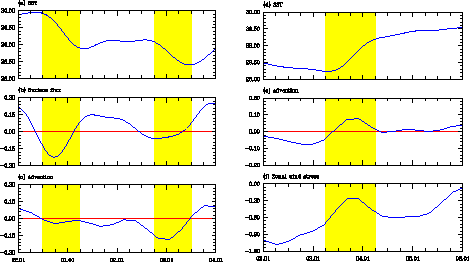
During late March and early April 1997, central Pacific SSTs (Fig. 4.20d) warmed in response to an oceanic Kelvin wave that was forced during the February MJO. That warming was primarily due to zonal temperature advection (Fig. 4.20e), promoted by strong eastward currents along with an east-west temperature gradient. After the passage of the Kelvin wave, zonal currents remained slightly eastward because trade winds (Fig. 4.20f) did not resume their pre-Kelvin wave strength. In addition, the east-west SST gradient was reduced after the Kelvin wave. As a result, temperature advection was negligible after the Kelvin wave, and SST continued to warm due to the positive surface heat flux that is typical for the region. The zonal current variation that is responsible for the temperature advection is forced, in part, by a local wind-stress fluctuation. So, if the MJO did contribute to this important SST warming through nonlinear interactions, then those interactions involve the coupling of atmospheric and oceanic dynamics.